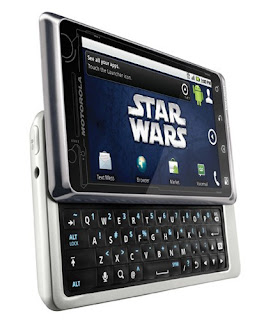To celebrate 30 years since the film hit theaters, customers with Android devices running Android 2.1 or higher will soon be able to get the Empire Strikes Back app from Android Market™. The app, only for Verizon Wireless customers, allows Jedi Masters to browse, preview and download Star Wars content related to Star Wars: Episode V The Empire Strikes Back.....
Motorola’s Droid 2 R2-D2 version will drop on September 30th for $249 after a $100 mail-in-rebate. Included is a dock, plenty of Star Wars branding, R2-D2 sounds and notifications and some sort of binocular application.
If you already own an Android phone, and $249 is a bit too rich for your blood, you’ll soon be able to download a Star Wars application that provides a comparable feature set as the the official handset for $2.99.
MAY THE DROID BE WITH YOU: LIMITED EDITION DROID™ R2-D2™ BY MOTOROLA LANDS ON VERIZON WIRELESS’ NETWORK
DROID™ R2-D2™ by Motorola Brings the Galactic Empire to Customers
BASKING RIDGE, N.J., and LIBERTYVILLE, Ill. – Verizon Wireless announced that the highly anticipated limited edition DROID™ R2-D2™ by Motorola will be available online at www.verizonwireless.com and in select Verizon Wireless Communication stores beginning Sept. 30. With a graphic design to look like the iconic Astromech Droid from the Star Wars™ Saga, the DROID™ R2-D2™ by Motorola will be packaged in a custom box resembling carbonite and come with a Star Wars media dock and wired stereo headset.
Exclusive content comes pre-loaded on the special edition smartphone, including:
· R2-D2 notification sounds and ringtones
· Four live wallpapers
· R2-D2 Clock Widget
· “The Best of R2-D2” video with the original Cantina music
· Exclusive Binoculars App
Star Wars Mobile App Available for All Customers with Android 2.1 phones
To celebrate 30 years since the film hit theaters, customers with Android devices running Android 2.1 or higher will soon be able to get the Empire Strikes Back app from Android Market™. The app, only for Verizon Wireless customers, allows Jedi Masters to browse, preview and download Star Wars content related to Star Wars: Episode V The Empire Strikes Back. Verizon Wireless customers can access premium Star Wars content for a one-time charge of $2.99.
The Star Wars mobile app will have the following features and content:
· Bounty Hunt Visual ID: Find and capture images around the Star Wars universe to unlock hidden content
· Sound and Photo Gallery
· Live Wallpapers:
o Blast the Probe Droid
o Luke Balancing Yoda
o Navigating the Asteroid Field
o Watch Bespin’s Cloud City
· Trivia Challenge: Answer trivia questions about The Empire Strikes Back
· Widgets
The DROID™ R2-D2™ by Motorola will be available for $249 after a $100 mail-in rebate with a new two-year customer agreement. Customers will need to subscribe to a Nationwide Talk plan or a Nationwide Talk & Text plan (beginning at $39.99 monthly access) and an Email and Web for Smartphone plan (beginning at $29.99 for unlimited monthly access). Customers will receive the rebate in the form of a debit card; upon receipt, customers may use the card as cash anywhere debit cards are accepted.
For more information on DROID™ R2-D2™ by Motorola, go to www.droiddoes.com/r2d2.
About Verizon Wireless
Verizon Wireless operates the nation’s most reliable and largest wireless voice and 3G data network, serving more than 92 million customers. Headquartered in Basking Ridge, N.J., with 79,000 employees nationwide, Verizon Wireless is a joint venture of Verizon Communications (NYSE, NASDAQ: VZ) and Vodafone (LSE, NASDAQ: VOD). For more information, visit www.verizonwireless.com. To preview and request broadcast-quality video footage and high-resolution stills of Verizon Wireless operations, log on to the Verizon Wireless Multimedia Library at www.verizonwireless.com/multimedia.
About Motorola
Motorola is known around the world for innovation in communications and is focused on advancing the way the world connects. From broadband communications infrastructure, enterprise mobility and public safety solutions to mobile and wireline digital communication devices that provide compelling experiences, Motorola is leading the next wave of innovations that enable people, enterprises and governments to be more connected and more mobile. Motorola (NYSE: MOT) had sales of US $22 billion in 2009.
For more information, please visit www.motorola.com.



















